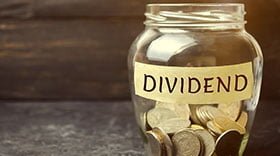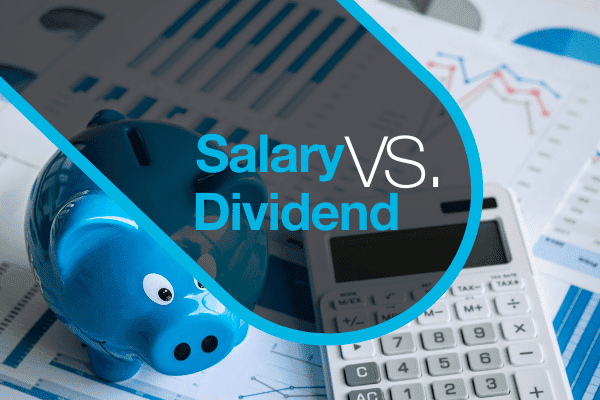As a business owner in Canada, deciding how to pay yourself is one of the most important financial and tax planning decisions you’ll make. Whether your business is newly incorporated or has been running for years, choosing between paying yourself a salary, dividends, or a mix of both can impact your taxes, cash flow, retirement savings, and even your eligibility for loans and benefits.But don't worry, we'll help you understand:1. The difference between salary and dividends2. Tax implications of each method3. Pros and cons4. How to choose the right approach for your unique situation
Let’s dive in!
1. What’s the Difference Between Salary and Dividends?

A) Salary
A salary is considered as an earned income. When you pay yourself a salary from your corporation;
- You receive a regular paycheck.
- Your corporation deducts income tax, Canada Pension Plan (CPP) & other payroll taxes.
- You receive a T4 slip at year-end.

B) Dividends
Dividends are paid to shareholders from the after-tax profits of the corporation;
- You do not need to withhold CPP or income tax at source.
- You receive a T5 slip for dividend income.
- Dividends are not a corporate expense.
Therefore, dividends are taxed at a lower personal rate due to the dividend tax credit but come from corporate income after tax deduction.
2. Tax Implications: Salary vs. Dividend
FEATURES OF SALARY
i) Corporate tax deduction; Yes (reduces corp. tax)
ii) CPP Contributions; Required (employee + employer)
iii) RRSP Contribution; Generates RRSP room
iv) EI Contributions ; Optional (if owner pays into)
v) Personal Tax Rate ; Taxed at marginal rates
vi) Reporting Slips; T4
vii) WSIB / Payroll Deductions ; Required
FEATURE OF DIVIDEND
i) Corporate tax deduction; No
ii) CPP Contributions; Not applicable
iii) RRSP Contribution; Generates RRSP room
iv) EI Contributions; Not applicable
v) Personal Tax Rate; Preferential tax rate (with credit)
vi) Reporting Slips; T5
vii) WSIB / Payroll Deductions; Not applicable
FEATURES OF SALARY
i) Corporate tax deduction; Yes (reduces corp. tax)
ii) CPP Contributions; Required (employee + employer)
iii) RRSP Contribution; Generates RRSP room
iv) EI Contributions ; Optional (if owner pays into)
v) Personal Tax Rate ; Taxed at marginal rates
vi) Reporting Slips; T4
vii) WSIB / Payroll Deductions ; Required
FEATURE OF DIVIDEND
i) Corporate tax deduction; No
ii) CPP Contributions; Not applicable
iii) RRSP Contribution; Generates RRSP room
iv) EI Contributions; Not applicable
v) Personal Tax Rate; Preferential tax rate (with credit)
vi) Reporting Slips; T5
vii) WSIB / Payroll Deductions; Not applicable
3. Pros and Cons of Paying Yourself
A SALARY
Pros:
• CPP Contributions: Builds future pension income.
• RRSP Eligibility: Earned income increases your contribution room.
• Loan Applications: Lenders often prefer T4 income.
• Regular Income: Helps with personal budgeting and consistency.
Cons:
• Higher Payroll Costs: Corporation pays both employer and employee CPP.
• Payroll Compliance: Requires payroll account, remittances, T4 filings.
• Immediate Tax Withholding: Income tax and CPP deducted monthly.
Dividends
Pros:
• No Payroll Setup Needed: Simple to issue via resolution or cheque.
• No CPP Contributions: Saves the corporation and you money upfront.
• Tax Efficiency (Sometimes): Lower tax rate due to dividend tax credit.
Cons:
• No CPP Contributions: No pension building.
• No RRSP Room: You lose out on tax-deferred retirement savings.
• Inconsistent Income: May vary depending on business performance.
• Less Favorable for Loans: Some lenders don’t consider dividend income as stable
A SALARY
Pros:
• CPP Contributions: Builds future pension income.
• RRSP Eligibility: Earned income increases your contribution room.
• Loan Applications: Lenders often prefer T4 income.
• Regular Income: Helps with personal budgeting and consistency.
Cons:
• Higher Payroll Costs: Corporation pays both employer and employee CPP.
• Payroll Compliance: Requires payroll account, remittances, T4 filings.
• Immediate Tax Withholding: Income tax and CPP deducted monthly.
Dividends
Pros:
• No Payroll Setup Needed: Simple to issue via resolution or cheque.
• No CPP Contributions: Saves the corporation and you money upfront.
• Tax Efficiency (Sometimes): Lower tax rate due to dividend tax credit.
Cons:
• No CPP Contributions: No pension building.
• No RRSP Room: You lose out on tax-deferred retirement savings.
• Inconsistent Income: May vary depending on business performance.
• Less Favorable for Loans: Some lenders don’t consider dividend income as stable

4. How to choose the right approach for your unique situation
Let’s take an example by a case study of our client (the names and figures are fictitious for the sake of privacy).
Case Study: Paying Yourself – Salary vs. Dividend
Client: Arjun Mehta, Owner of a Marketing Agency in London, Ontario
Year: 2025
Business Structure: Incorporated
Annual Net Profit: $150,000
Personal Financial Goals:
• Save for retirement (RRSP)
• Buy a home in the next 12–18 months
• Keep monthly cash flow predictable
Arjun’s Situation
He incorporated his digital marketing agency in 2022. In 2025, his business is thriving with $150,000 in net profit after business expenses. He is the sole shareholder and works full-time in the business.
He came to our accounting firm Bhundhoo tax and accounting asking:
“Should I take a salary, a dividend, or both? I want to save on taxes, but also qualify for a mortgage and start saving for retirement.”
Here, what we suggested after Analyzing the Numbers:
We go through three options and decide the most suitable and appropriate one according to his needs.
Option 1: 100% Salary ($120,000)
- Corporate tax: Corporation deducts $120,000 as salary → Taxable profit = $30,000
- Corporate tax on $30,000: ≈ $3,660 (small business rate of 12.2%)
- Personal tax on $120,000 salary: ≈ $29,000 (2025 Ontario rates)
- CPP contribution: $7,735 (split between employer & employee)
- RRSP room created: $22,000
Option 2: 100% Dividends (~$120,000 grossed-up)
- Corporate tax on $150,000: ≈ $18,300 (12.2%)
- After-tax retained earnings: ≈ $131,700
- Personal dividend tax on $120,000: ≈ $17,500
- CPP contribution: $0
- RRSP room created: $0
Option 3: Mixed Strategy (Salary $65,000 + Dividends $45,000)
- Corporate tax after salary: ≈ $4,270
- CPP contribution: ~$6,700
- Personal tax: ≈ $19,000 total (combined salary & dividend)
- RRSP room created: ~$11,700
- Balanced cash flow + tax efficiency
Final Recommendation: Mixed Strategy
We recommended that Arjun take:
• $65,000 salary to ensure regular income, contribute to CPP, and generate RRSP room
• $45,000 dividend to top up his income at a lower tax rate and reduce overall payroll cost
This gave him:
• Steady T4 income for mortgage qualification
• RRSP room to contribute during tax season
• Lower effective tax rate than salary alone
• Future CPP benefits
• Simpler year-end reporting than full payroll setup
Outcome in 2025:
• Qualified for a mortgage pre-approval based on $65K salary
• Opened his first RRSP account and contributed $10,000
• Saved over $3,000 in taxes compared to 100% salary
• Avoided CRA penalties and stayed compliant with T4 and T5 filings
• Created a sustainable system to repeat yearly
Let’s take an example by a case study of our client (the names and figures are fictitious for the sake of privacy).
Case Study: Paying Yourself – Salary vs. Dividend
Client: Arjun Mehta, Owner of a Marketing Agency in London, Ontario
Year: 2025
Business Structure: Incorporated
Annual Net Profit: $150,000
Personal Financial Goals:
• Save for retirement (RRSP)
• Buy a home in the next 12–18 months
• Keep monthly cash flow predictable
Arjun’s Situation
He incorporated his digital marketing agency in 2022. In 2025, his business is thriving with $150,000 in net profit after business expenses. He is the sole shareholder and works full-time in the business.
He came to our accounting firm Bhundhoo tax and accounting asking:
“Should I take a salary, a dividend, or both? I want to save on taxes, but also qualify for a mortgage and start saving for retirement.”
Here, what we suggested after Analyzing the Numbers:
We go through three options and decide the most suitable and appropriate one according to his needs.
Option 1: 100% Salary ($120,000)
- Corporate tax: Corporation deducts $120,000 as salary → Taxable profit = $30,000
- Corporate tax on $30,000: ≈ $3,660 (small business rate of 12.2%)
- Personal tax on $120,000 salary: ≈ $29,000 (2025 Ontario rates)
- CPP contribution: $7,735 (split between employer & employee)
- RRSP room created: $22,000
Option 2: 100% Dividends (~$120,000 grossed-up)
- Corporate tax on $150,000: ≈ $18,300 (12.2%)
- After-tax retained earnings: ≈ $131,700
- Personal dividend tax on $120,000: ≈ $17,500
- CPP contribution: $0
- RRSP room created: $0
Option 3: Mixed Strategy (Salary $65,000 + Dividends $45,000)
- Corporate tax after salary: ≈ $4,270
- CPP contribution: ~$6,700
- Personal tax: ≈ $19,000 total (combined salary & dividend)
- RRSP room created: ~$11,700
- Balanced cash flow + tax efficiency
Final Recommendation: Mixed Strategy
We recommended that Arjun take:
• $65,000 salary to ensure regular income, contribute to CPP, and generate RRSP room
• $45,000 dividend to top up his income at a lower tax rate and reduce overall payroll cost
This gave him:
• Steady T4 income for mortgage qualification
• RRSP room to contribute during tax season
• Lower effective tax rate than salary alone
• Future CPP benefits
• Simpler year-end reporting than full payroll setup
Outcome in 2025:
• Qualified for a mortgage pre-approval based on $65K salary
• Opened his first RRSP account and contributed $10,000
• Saved over $3,000 in taxes compared to 100% salary
• Avoided CRA penalties and stayed compliant with T4 and T5 filings
• Created a sustainable system to repeat yearly
Key Lessons to learn from this case for Business Owners are;
• Mixing salary and dividends offers both flexibility and tax efficiency.
• You don’t need to pick one method—customization is key.
• Strategic planning improves mortgage eligibility, retirement savings, and CRA compliance.
• Always consider CPP, RRSPs, tax brackets, and long-term goals.

Pre Plan: Talk to a Tax Professional
Choosing the right compensation structure is not a one-size-fits-all decision. It depends on:
• Your business profits
• Personal income needs
• Long-term retirement planning
• Tax brackets and marginal rates
• Your age, family situation, and other income sources
That’s why working with an accountant or tax advisor can save you thousands in taxes and help you build long-term financial security.

Conclusion
As a Canadian business owner, paying yourself through salary, dividends, or a blend of both can be a powerful tool for tax planning and wealth building. Each method has its own advantages, and the right strategy depends on your unique goals and financial situation.
Don’t leave money on the table or risk CRA penalties. If you’re unsure about how to structure your compensation, now is the perfect time to get expert advice.
At Bhundhoo Tax Professional Corporation, we help business owners across Ontario make smart decisions about how to pay themselves, reduce taxes, and grow wealth.
- Personalized tax planning
- Year-round corporate support
- RRSP, CPP, and dividend strategy
- CRA compliance and filings
